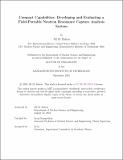| dc.description.abstract | Technological advances in the thorium fuel cycle and other advanced reactor concepts suggest their possible commercialization for nuclear power use in the next ten years. Although the thorium cycle shares many aspects with the uranium and plutonium fuel cycles, it introduces the requirement for the nondestructive assay of multiple isotopes (²³8U, ²³²Th, ²³³U, ²³⁵U, or ²³⁹Pu) in varied concentrations and chemical or physical forms. Current methodologies used for safeguarding the uranium and plutonium fuel cycles are either unsuitable for quantifying many of these isotopes or lack the ability to differentiate between them effectively. This work presents an experimental evaluation of a portable Neutron Resonance Capture Analysis (NRCA) system sensitive to isotopes with neutron capture resonances in the epithermal range (1-100 eV). NRCA is a technique traditionally used for nuclear data collection and nondestructive assay of archaeological materials, typically conducted at large accelerator facilities with beamlines in excess of ten meters. This research miniaturizes the system to a two-meter beamline using a portable deuterium-tritium neutron generator. It builds upon the foundation of a portable Neutron Resonance Transmission Analysis (NRTA) system, utilizing capture gamma rays to generate a signal, in contrast to the neutron transmission measurements of NRTA. The NRCA technique is evaluated in this novel, portable configuration first using nonradioactive samples for optimization and then progressing to depleted uranium and thorium salt samples. Through a research partnership with Pacific Northwest National Laboratory, the technique was tested using highly enriched uranium, 233U and high-assay, low-enrichment uranium (HALEU) samples. Field portability tests demonstrated its ability to operate safely in field conditions, with operator doses remaining well within occupational limits. The system was able to identify multiple mid- and high-Z materials by reconstructing their neutron resonance profiles in experiments as brief as 20 minutes. It successfully differentiated between nuclear fuel cycle isotopes in composite samples as small as 2 grams, with limited success in quantifying the areal densities of uranium and thorium. These results suggest that NRCA, especially when used in concert with NRTA and other neutron-interrogation techniques, has the potential to rapidly and nondestructively quantify and characterize isotopes of interest in support of safeguards material accountancy. | |
